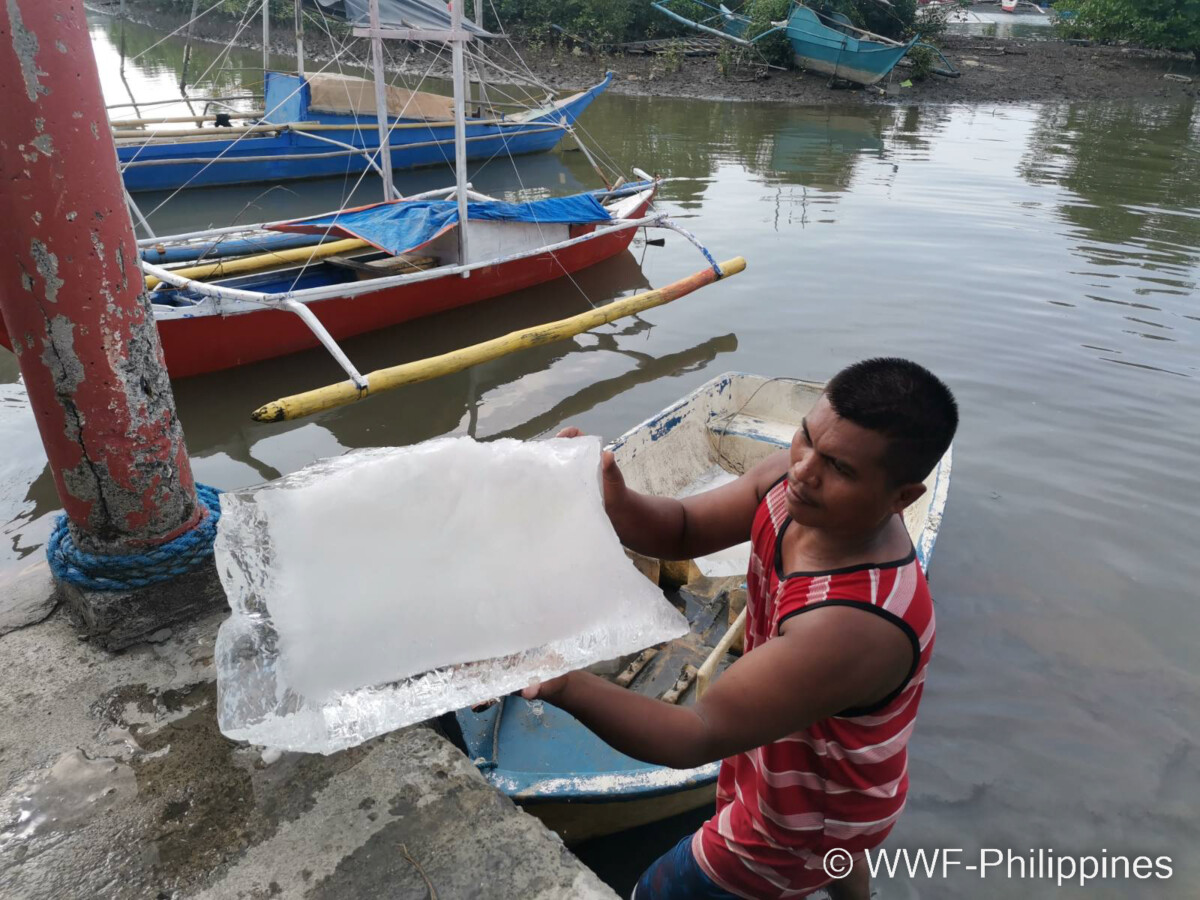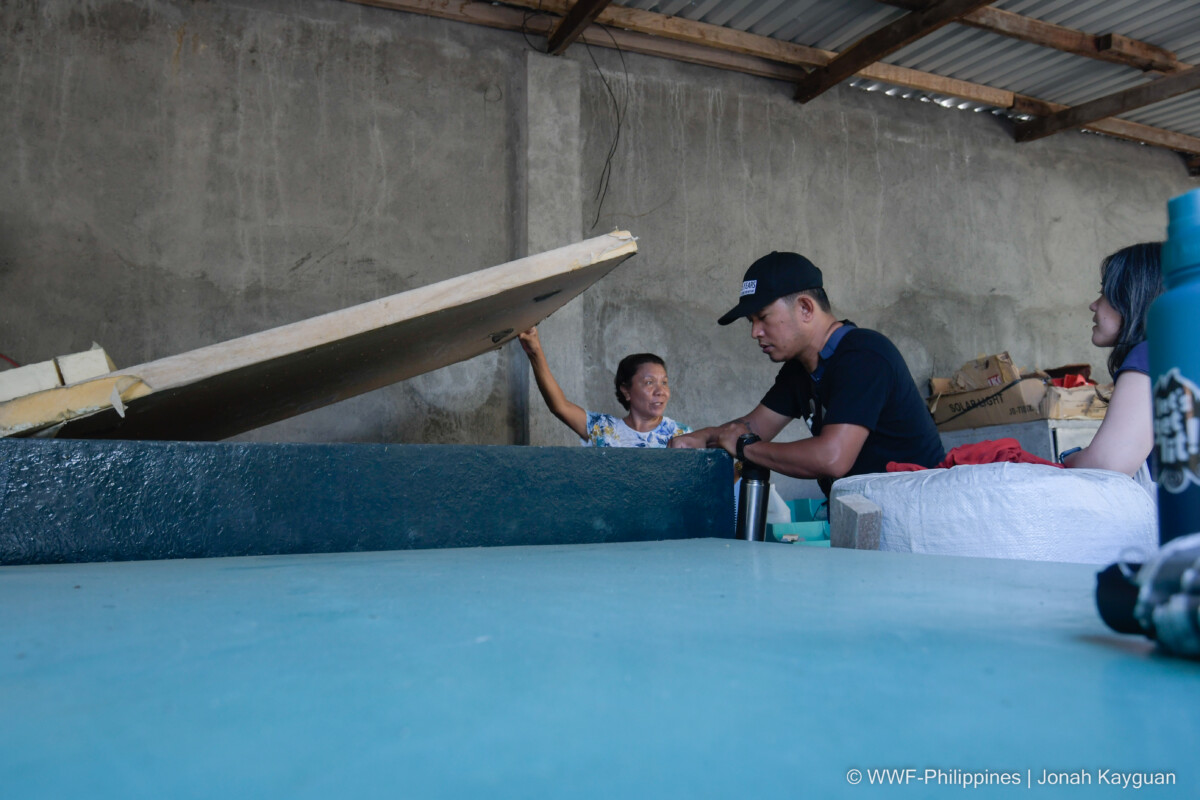JAM Seafoods Working on Providing Free Ice and Potential Livelihood for Occidental Mindoro Small-Scale Tuna Fishers
The price of tuna highly depends on its quality. This is based on its color and texture, which deteriorates quickly if not handled properly. Tuna fishers follow a meticulous process in order to maintain the quality of their catch, and a significant step in this process involves the use of ice. Once a tuna is caught, it should be stored in an ice box filled with a slurry mixture of two parts ice and one part sea water. However, for the tuna fishers of Occidental Mindoro, ice is difficult and expensive to come by.

Tuna fishers need to bring blocks of ice on fishing trips to help preserve the quality of their catch.
The amount of ice needed for each fishing trip depends on many factors - the duration of the trip, the carrying capacity of the boat, the size of the ice box, and ultimately, the available budget. Ramil Garay, the Chairman of the Sta. Cruz Tuna Fishers Association, shares that there is often a shortage of ice during peak seasons when boats simultaneously leave for fishing trips. He laments that big commercial fishing boats are given priority over small-scale fishers when it comes to the supply of ice. This forces them to source from Batangas, a separate province accessible by cargo ships. Leobert Monzales, a tuna fisher from Sablayan, also shares that they sometimes buy ice from San Jose, a municipality over 80 km away by land. The transportation costs needed for delivery inflates the price of ice, sometimes even reaching over P700 per block. This further burdens fishers with higher operating costs, forcing some to forego purchasing ice altogether, sacrificing the quality of their catch and endangering their profits.
Further down the supply chain, tuna processors also suffer from the ice shortage. Sam Garcia, President of JAM Seafoods Inc., shares that the tuna they buy from fishers who don’t use ice or have insufficient ice, more often than not, have high rates of rejection. This means that these tuna will either be sold at much lower prices or not sold at all, which hurts their business. In order to get better quality fish, JAM Seafoods Inc. understood that they had to intervene at the level of the fishers. Hence, they decided to install an ice making machine in Tabuk, Sablayan. The 6-horsepower ice making machine is capable of producing 1.2 tons of ice blocks over 24 hours. Garcia plans to tweak the mechanism to eventually increase production to 1.5 tons.

Project Buhay team members check out JAM Seafoods Inc.'s ice-making machine installed in their buying station at Sitio Tabuk, Sablayan, Occidental Mindoro.
Garcia’s plan is to provide the ice for free to small-scale tuna fishers with municipal boats. In exchange, these fishers will sell their catch to JAM Seafoods Inc. By providing free ice, he hopes to source better quality fish and help increase the percentage of export quality tuna, creating a win-win situation among fishers, distributors, and processors. Garcia has also expressed the intention of handing over the machine to the Occidental Mindoro Federation of Tuna Fishers Association (OMFTFA) once they have managed to master operating the machine with little to no supervision. “Eventually, I will give it to the group of fishers who will use it so that they have extra income. Part of the learnings from the different projects of WWF, is it’s important that they have other sources of income,” he shares. JAM Seafoods Inc. is still working through some operational challenges to get the machine fully operational. One of the obstacles is Occidental Mindoro’s rotational brownouts, pushing them to explore using a combination of generators and solar power as a work-around. They hope to have the ice making machine running in time for summer, the season they experience the highest rate of rejections for tuna. If proven to be successful, Garcia plans to further expand operations across Sablayan, Occidental Mindoro and Tiwi, Albay.
JAM Seafoods Inc. has been a dedicated partner of WWF-Philippines’ sustainable tuna projects over the past decade. The most recent one, Project Buhay: Tuna Habambuhay, Dagdag Hanapbuhay, funded by the European Union (EU), aims to help tuna fishers increase the value of their catch by improving quality and reducing post-harvest losses through the use of cold chain facilities. Similar to Garcia’s business model, Project Buhay aims to provide several ice making machines to the major fish landing centers of Occidental Mindoro by 2025 in order to serve as sources of ice and alternative livelihoods for small-scale tuna fishers. The project hopes to learn from JAM Seafoods Inc.’s ice making machine endeavor and incorporate their best practices.
This article was produced with the financial support of the European Union. Its contents are the sole responsibility of WWF-Philippines and do not necessarily reflect the views of the European Union.
For more information, please contact:
Ms. Melody Melo-Rijk
Project Manager
Project Buhay (a.k.a Mindoro Strait Sustainable and Equitable Tuna for Bankability)
mmelorijk@wwf.org.ph
Ms. Lorayne Roque
Integrated Marketing Communications Specialist
Project Buhay (a.k.a Mindoro Strait Sustainable and Equitable Tuna for Bankability)
lroque@wwf.org.ph
About WWF:
WWF is one of the world’s largest and most respected independent conservation organizations, with over 5 million supporters and a global network active in over 100 countries. WWF's mission is to stop the degradation of the Earth's natural environment and to build a future in which humans live in harmony with nature, by conserving the world's biological diversity, ensuring that the use of renewable natural resources is sustainable, and promoting the reduction of pollution and wasteful consumption.
WWF-Philippines has been successfully implementing various conservation projects to help protect some of the most biologically-significant ecosystems in Asia since its establishment as the 26th national organization of the WWF network in 1997.
About Project Buhay:
Project Buhay, internationally known as “Mindoro Strait Sustainable and Equitable Tuna for Bankability” project, is funded by the European Union through their Switch Asia Grants Programme. It aims to make the tuna fishing industry of Occidental Mindoro sustainable and equitable by equipping fishers with proper tuna post-processing knowledge and resources, identifying and growing alternative livelihoods, creating a portfolio of bankable projects, and sharing community stories to inspire replication in other communities. This project will run until January 2025.
About SWITCH Asia:
Launched in 2007, the SWITCH-Asia programme is the largest European Union-funded programme promoting Sustainable Consumption and Production (SCP) supporting 24 countries in Asia and Central Asia. The overall objective of the programme is to promote sustainable and inclusive growth, contribute to the economic prosperity and poverty reduction in Asia and Central Asia and to a transition towards a low-carbon, resource-efficient and circular economy. Learn more at: www.switch-asia.eu

